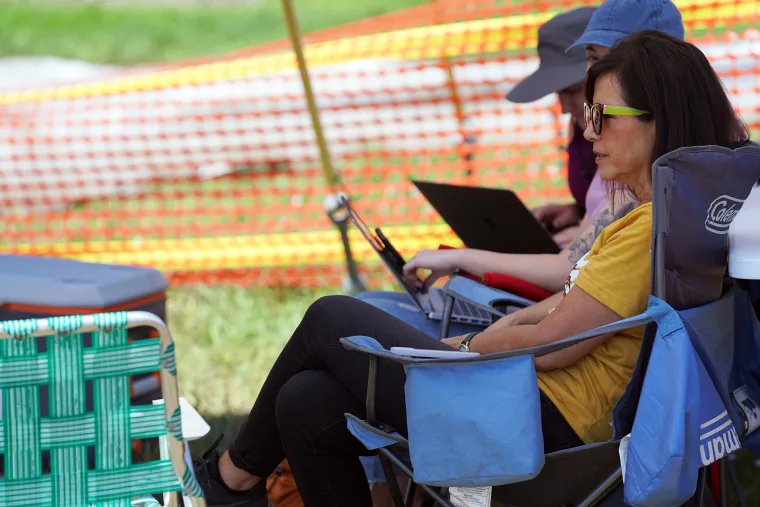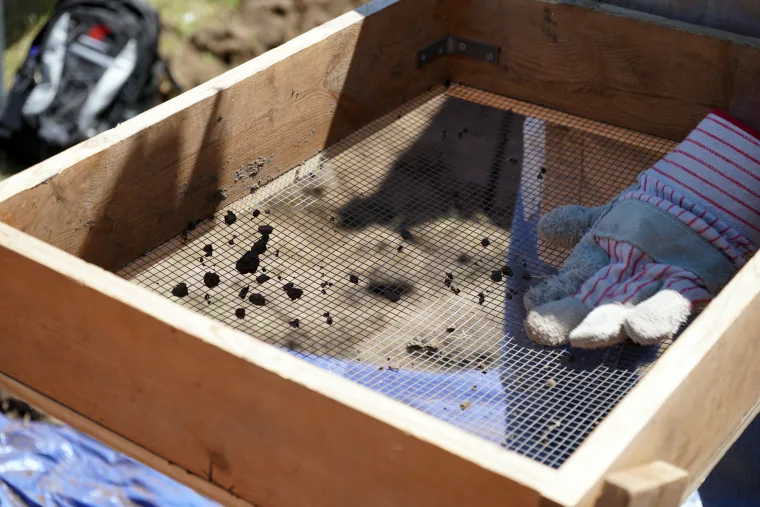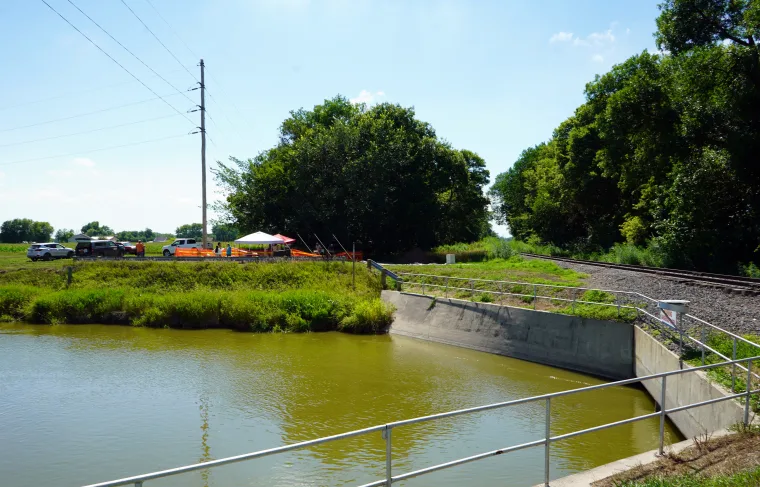Somber mood at Nebraska boarding school grave dig
Experts are digging in rural Nebraska on a site where they believe as many as 80 boarding school students were buried. Some 86 students are believed to have died at Genoa Boarding School
Kevin Abourezk
ICT

A volunteer for the Nebraska state archaeologist’s office sifts through dirt Wednesday, July 12, 2023 taken from a hole being dug at the former Genoa Boarding School, where as many as 80 former students are believed to have been buried. The student cemetery in Genoa, Nebraska was lost following the school’s closure in 1934. (Kevin Abourezk, ICT News)
WARNING: This story contains disturbing details about residential and boarding schools. If you are feeling triggered, here is a resource list for trauma responses from the National Native American Boarding School Healing Coalition in the U.S. In Canada, the National Indian Residential School Crisis Hotline can be reached at 1-866-925-4419.
Stacy Laravie had to be here.
The 38-year-old Ponca woman traces her ancestry back to several former students of the sprawling Indian Industrial School at Genoa, today known as the Genoa Boarding School. Her great-grandfather and great-grandmother attended the school in northeast Nebraska. But her great grandfather didn’t stay.
“He ran away,” she said. “He was pretty lucky.”
Many others weren’t as fortunate, and some died while attending the school, which opened in 1884 and closed in 1934.
As she shared her story, Laravie stood just a few feet away from where archaeologists dug a small rectangular hole in the ground, searching for the remains of children who died at the Genoa Boarding School.
This week, the Nebraska state archaeologist and two teammates began digging into ground where they believe as many as 80 students from the school were buried. The former cemetery’s location was lost after the school’s closure, and the Nebraska Commission on Indian Affairs requested the state archaeologist’s help in locating it. The site is about 90 miles west of Omaha.

Judi gaiashkibos, executive director of the Indian commission, said she felt it is important to give tribes and families of deceased students the opportunity to conduct funerary ceremonies and lay their loved ones to rest however they see fit. She said the dig this week has been bittersweet.
“We want to find them, but we don’t want to find them,” she said. “What we want to do is put those spirits to rest.”
The dig site is bordered by a canal and railroad tracks. Today, little remains of the once sprawling 640-acre campus that was home to as many as 600 students at its peak. The buildings that remain today are located to the north of the dig site.
Genoa was but one of more than 400 boarding schools that were designed to assimilate Indigenous people into White culture by separating students from their families and cutting them off from their culture. The legacy of boarding schools has been in the spotlight after more than 200 children’s remains were found buried at what was once Canada’s largest Indigenous residential school.
“There’s a lot of trauma from all of that,” gaiashkibos said. “We have to tell the truth and shed light on this.”
At least 86 students are believed to have died at the school, according to newspaper clippings, records and a student’s letter. Students usually died of diseases such as tuberculosis and typhoid, but at least one death was blamed on an accidental shooting.
Researchers identified 49 of the children killed but have not been able to find names for 37 students. The bodies of some of those children were returned to their homes but others are believed to have been buried on the school grounds at a location long ago forgotten.
In 2022, the U.S. Interior Department released a report on federal-run boarding schools and Secretary Deb Haaland, Laguna Pueblo, has been traveling to sites where boarding schools were located to gather oral testimonies from survivors and descendants of survivors.

Dave Williams, the Nebraska state archaeologist, has been working at the dig site since Monday, hoisting shovels laden with soil into buckets that volunteers then sift through to try to find remains or funerary objects. As of Thursday, Williams and his team had found virtually nothing at the site other than a very small amount of tissue that could be from a human or an animal of some sort.
He said his office identified the site after dogs trained to detect the faint odor of decaying remains alerted to possible remains at the site and ground-penetrating radar also detected what could be a coffin at the site. He said he planned to finish digging Thursday.
If nothing is found at the site, he said he plans to again attempt to identify other possible locations that his team should investigate. If his team discovers human remains at the site, it will work with the Nebraska Commission on Indian Affairs in deciding what happens next. They could rebury the remains or exhume the bodies and return them to their respective tribes.
They could potentially use DNA to identify the region of the country each child was from, but it will be difficult to identify each student’s specific tribe, Williams said.

Gaiashkibos, whose mother attended the school in the late 1920s, said the dig this week has been a somber, personal occasion and she hopes it might bring closure to families who’ve wondered what happened to their relatives who never returned home from Genoa.
She said she plans to consult with the nearly 40 tribes who sent students to Genoa on what to do if remains are found.
“We think it will help with the healing and closure,” she said. “Let’s honor them in the right way, however the tribes want to.”
Laravie said it would be truly powerful to see tribes welcome home their loved ones through ceremonies, considering the Genoa Boarding School was designed to cut students off from their cultures.
Along with two Omaha tribal officials, including the tribe’s historic preservation officer, Laravie stood watch over the dig site Wednesday and Thursday. A traditional knowledge-keeper for her tribe, the Ponca Tribe of Nebraska, she said she came to ensure any remains found would be treated respectfully and that tribal officials would be consulted throughout the dig.
“It’s very hard, very emotional,” she said. “I’m a mother. I couldn’t imagine not seeing my children again.”






